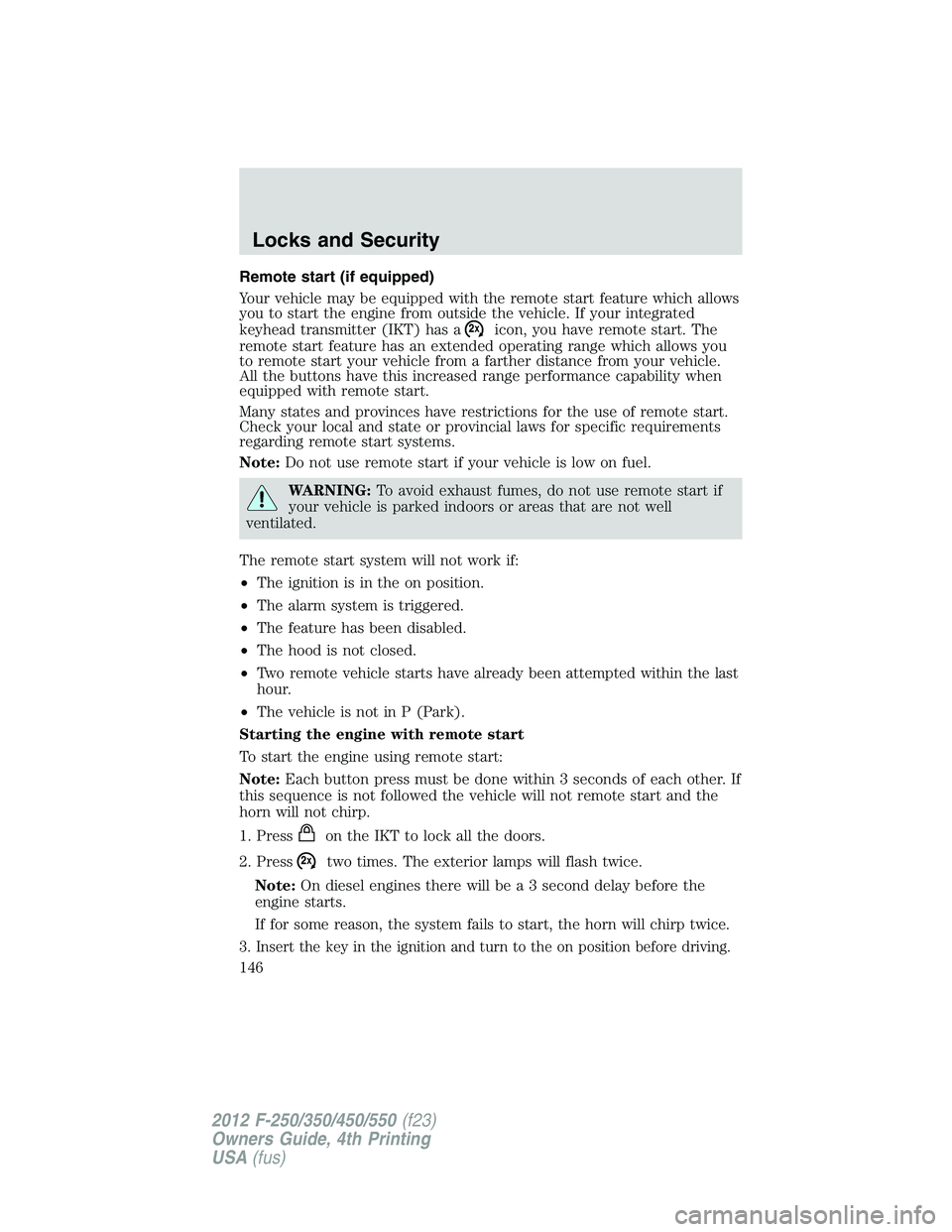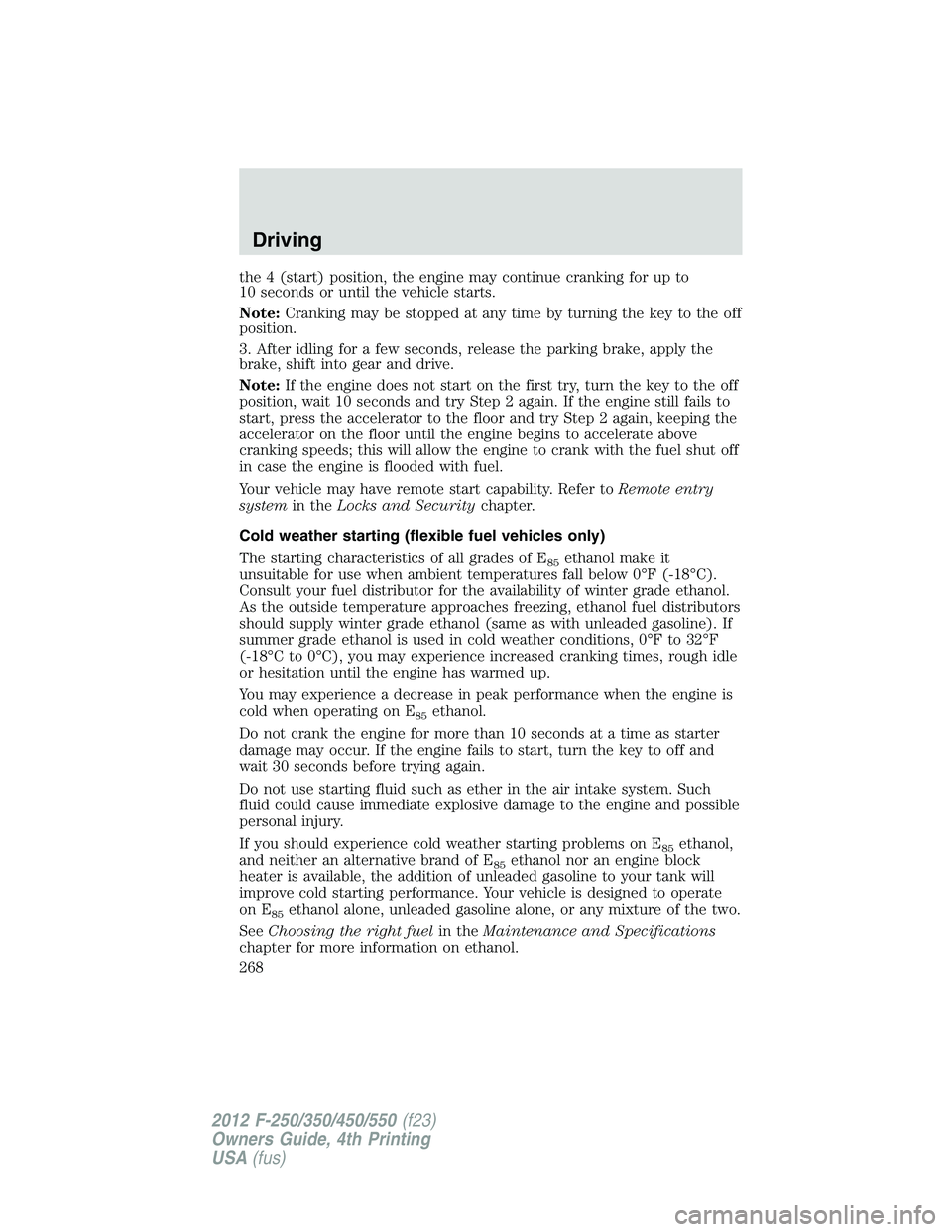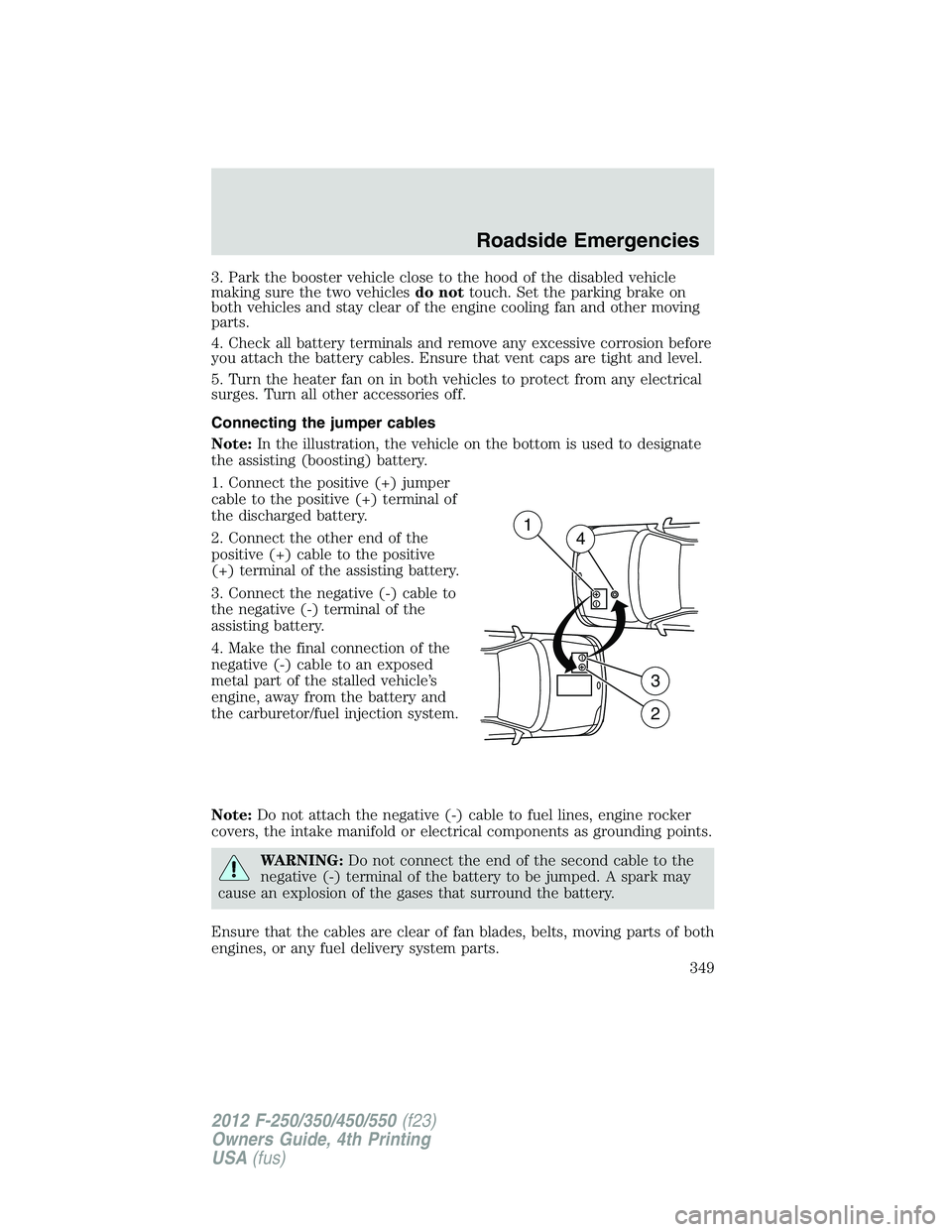2012 FORD F550 fuel cap
[x] Cancel search: fuel capPage 39 of 448

• Low Fuel Operation: If the message appears when the vehicle is warm
and during low fuel tank level operation, i.e. the tank level is at or
very near empty, refuel the vehicle and operate the vehicle. If the
message reappears after fueling, see below. If the message does not
come back, the low fuel pressure condition was due to low fuel levels
in the fuel tank.
• Normal Operation: If the message appears during normal operation
when the vehicle / engine is fully warm, and fuel level is not low, the
fuel filters must be changed regardless of the maintenance schedule
interval. If replacement of the fuel filter does not remedy the low fuel
pressure message during normal operation as defined above, please
take the vehicle to your authorized dealer.
OPTIONAL MESSAGE CENTER (IF EQUIPPED)
Your vehicle’s message center is capable of monitoring many vehicle
systems and will alert you to potential vehicle problems and various
conditions with a informational messages and/or warnings.
The message center is also used to program/configure the different
features of your vehicle.
The message center display is located in the instrument cluster. Use the
steering wheel mounted buttons to navigate through the message center.
Press the up/down buttons to move
up/down through the message
center choices.
Press the left/right buttons to move
left/right through the message
center choices. OK
OKInstrument Cluster
39
2012 F-250/350/450/550 (f23)
Owners Guide, 4th Printing
USA (fus)
Page 48 of 448

Compass/transmission indicator displays
The compass heading will display in the upper right corner of the message
center; the transmission gear indicator displays in the right side of the
message center when using the SelectShift Automatic™ transmission
feature. These displays will not be shown in all screen modes. For example:
when programming certain vehicle features or in certain information menus.
System warnings and status messages
System warnings alert you to possible problems or malfunctions in your
vehicle’s operating systems.
In the event of a multiple warning situation, the message center will cycle
the display to show all warnings by displaying each one for four seconds.
The message center will display the last selected feature if there are no
more warning messages.
Types of messages and warnings:
• Some messages will appear briefly to inform you of something you
may need to take action on or be informed of.
• Some messages will appear once and then again when the vehicle is
restarted.
• Some messages will reappear after clearing or being reset if a problem
or condition is still present and needs your attention.
• Some messages can be acknowledged and reset by pressing OK. This
allows you to use the full message center functionality by clearing the
message.
DOOR AJAR — Displayed when the door is not completely closed.
DRIVER DOOR AJAR — Displayed when the driver door is not
completely closed.
LEFT REAR DOOR AJAR — Displayed when the rear left door is not
completely closed.
PASSENGER DOOR AJAR — Displayed when the passenger door is
not completely closed.
RIGHT REAR DOOR AJAR — Displayed when the rear right door is
not completely closed.
CHECK FUEL CAP — Displayed when the fuel cap may not be
properly closed. Refer to What you should know about automotive
fuels in the Maintenance and Specifications chapter.
FUEL LEVEL LOW — Displayed as a reminder of a low fuel condition.Instrument Cluster
48
2012 F-250/350/450/550 (f23)
Owners Guide, 4th Printing
USA (fus)
Page 54 of 448

WATER IN FUEL DRAIN FILTER SEE MANUAL (if equipped) —
Displayed when the water separator has reached a predetermined
capacity and needs to be drained. Refer to your diesel supplement for
more information.
LOW TIRE PRESSURE — Displayed when one or more tires on your
vehicle have low tire pressure. Refer to Inflating Your Tires in the
Tires, Wheels and Loading chapter.
TIRE PRESSURE MONITOR FAULT — Displayed when the Tire
Pressure Monitoring System is malfunctioning. If the warning stays on or
continues to come on, have the system inspected by your authorized
dealer.
TIRE PRESSURE SENSOR FAULT — Displayed when a tire pressure
sensor is malfunctioning, or your spare tire is in use. For more
information on how the system operates under these conditions, refer to
Understanding Your Tire Pressure Monitoring System (TPMS) in the
Tires, Wheels and Loading chapter. If the warning stays on or
continues to come on, contact your authorized dealer as soon as
possible.
TIRES NOT TRAINED - REPEAT — Displayed when an error occurs
while training the TPMS. Refer to TPMS reset procedure in the Tires,
Wheels and Loading chapter for more information.
TRAIN INNER LEFT REAR TIRE — Displayed when training the
TPMS. Refer to TPMS reset procedure in the Tires, Wheels and
Loading chapter for more information.
TRAIN INNER RIGHT REAR TIRE — Displayed when training the
TPMS. Refer to TPMS reset procedure in the Tires, Wheels and
Loading chapter for more information.
TRAIN LEFT FRONT TIRE — Displayed when training the TPMS
system. Refer to TPMS reset procedure in the Tires, Wheels and
Loading chapter for more information.
TRAIN LEFT REAR TIRE — Displayed when training the TPMS
system. Refer to TPMS reset procedure in the Tires, Wheels and
Loading chapter for more information.
TRAIN RIGHT FRONT TIRE — Displayed when training the TPMS
system. Refer to TPMS reset procedure in the Tires, Wheels and
Loading chapter for more information.
TRAIN RIGHT REAR TIRE — Displayed when training the TPMS
system. Refer to TPMS reset procedure in the Tires, Wheels and
Loading chapter for more information.Instrument Cluster
54
2012 F-250/350/450/550 (f23)
Owners Guide, 4th Printing
USA (fus)
Page 146 of 448

Remote start (if equipped)
Your vehicle may be equipped with the remote start feature which allows
you to start the engine from outside the vehicle. If your integrated
keyhead transmitter (IKT) has a icon, you have remote start. The
remote start feature has an extended operating range which allows you
to remote start your vehicle from a farther distance from your vehicle.
All the buttons have this increased range performance capability when
equipped with remote start.
Many states and provinces have restrictions for the use of remote start.
Check your local and state or provincial laws for specific requirements
regarding remote start systems.
Note: Do not use remote start if your vehicle is low on fuel.
WARNING: To avoid exhaust fumes, do not use remote start if
your vehicle is parked indoors or areas that are not well
ventilated.
The remote start system will not work if:
• The ignition is in the on position.
• The alarm system is triggered.
• The feature has been disabled.
• The hood is not closed.
• Two remote vehicle starts have already been attempted within the last
hour.
• The vehicle is not in P (Park).
Starting the engine with remote start
To start the engine using remote start:
Note: Each button press must be done within 3 seconds of each other. If
this sequence is not followed the vehicle will not remote start and the
horn will not chirp.
1. Press on the IKT to lock all the doors.
2. Press two times. The exterior lamps will flash twice.
Note: On diesel engines there will be a 3 second delay before the
engine starts.
If for some reason, the system fails to start, the horn will chirp twice.
3. Insert the key in the ignition and turn to the on position before driving.Locks and Security
146
2012 F-250/350/450/550 (f23)
Owners Guide, 4th Printing
USA (fus)
Page 244 of 448

Follow these guidelines when using snow tires and chains:
• If possible, avoid fully loading your vehicle.
• Use only SAE Class S chains.
• Install chains securely, verifying that the chains do not touch any
wiring, brake lines or fuel lines.
• Drive cautiously. If you hear the chains rub or bang against your
vehicle, stop and retighten the chains. If this does not work, remove
the chains to prevent damage to your vehicle.
• Remove the tire chains when they are no longer needed. Do not use
tire chains on dry roads.
VEHICLE LOADING – WITH AND WITHOUT A TRAILER
This section will guide you in the proper loading of your vehicle and/or
trailer, to keep your loaded vehicle weight within its design rating
capability, with or without a trailer. Properly loading your vehicle will
provide maximum return of vehicle design performance. Before loading
your vehicle, familiarize yourself with the following terms for determining
your vehicle’s weight ratings, with or without a trailer, from the vehicle’s
Tire Label or Safety Compliance Certification Label:
Base Curb Weight – is the weight of the vehicle including a full tank of
fuel and all standard equipment. It does not include passengers, cargo, or
optional equipment.
Vehicle Curb Weight – is the weight of your new vehicle when you
picked it up from your authorized dealer plus any aftermarket
equipment.Tires, Wheels and Loading
244
2012 F-250/350/450/550 (f23)
Owners Guide, 4th Printing
USA (fus)
Page 268 of 448

the 4 (start) position, the engine may continue cranking for up to
10 seconds or until the vehicle starts.
Note: Cranking may be stopped at any time by turning the key to the off
position.
3. After idling for a few seconds, release the parking brake, apply the
brake, shift into gear and drive.
Note: If the engine does not start on the first try, turn the key to the off
position, wait 10 seconds and try Step 2 again. If the engine still fails to
start, press the accelerator to the floor and try Step 2 again, keeping the
accelerator on the floor until the engine begins to accelerate above
cranking speeds; this will allow the engine to crank with the fuel shut off
in case the engine is flooded with fuel.
Your vehicle may have remote start capability. Refer to Remote entry
system in the Locks and Security chapter.
Cold weather starting (flexible fuel vehicles only)
The starting characteristics of all grades of E 85
ethanol make it
unsuitable for use when ambient temperatures fall below 0°F (-18°C).
Consult your fuel distributor for the availability of winter grade ethanol.
As the outside temperature approaches freezing, ethanol fuel distributors
should supply winter grade ethanol (same as with unleaded gasoline). If
summer grade ethanol is used in cold weather conditions, 0°F to 32°F
(-18°C to 0°C), you may experience increased cranking times, rough idle
or hesitation until the engine has warmed up.
You may experience a decrease in peak performance when the engine is
cold when operating on E 85
ethanol.
Do not crank the engine for more than 10 seconds at a time as starter
damage may occur. If the engine fails to start, turn the key to off and
wait 30 seconds before trying again.
Do not use starting fluid such as ether in the air intake system. Such
fluid could cause immediate explosive damage to the engine and possible
personal injury.
If you should experience cold weather starting problems on E 85
ethanol,
and neither an alternative brand of E 85
ethanol nor an engine block
heater is available, the addition of unleaded gasoline to your tank will
improve cold starting performance. Your vehicle is designed to operate
on E 85
ethanol alone, unleaded gasoline alone, or any mixture of the two.
See Choosing the right fuel in the Maintenance and Specifications
chapter for more information on ethanol.Driving
268
2012 F-250/350/450/550 (f23)
Owners Guide, 4th Printing
USA (fus)
Page 349 of 448

3. Park the booster vehicle close to the hood of the disabled vehicle
making sure the two vehicles do not touch. Set the parking brake on
both vehicles and stay clear of the engine cooling fan and other moving
parts.
4. Check all battery terminals and remove any excessive corrosion before
you attach the battery cables. Ensure that vent caps are tight and level.
5. Turn the heater fan on in both vehicles to protect from any electrical
surges. Turn all other accessories off.
Connecting the jumper cables
Note: In the illustration, the vehicle on the bottom is used to designate
the assisting (boosting) battery.
1. Connect the positive (+) jumper
cable to the positive (+) terminal of
the discharged battery.
2. Connect the other end of the
positive (+) cable to the positive
(+) terminal of the assisting battery.
3. Connect the negative (-) cable to
the negative (-) terminal of the
assisting battery.
4. Make the final connection of the
negative (-) cable to an exposed
metal part of the stalled vehicle’s
engine, away from the battery and
the carburetor/fuel injection system.
Note: Do not attach the negative (-) cable to fuel lines, engine rocker
covers, the intake manifold or electrical components as grounding points.
WARNING: Do not connect the end of the second cable to the
negative (-) terminal of the battery to be jumped. A spark may
cause an explosion of the gases that surround the battery.
Ensure that the cables are clear of fan blades, belts, moving parts of both
engines, or any fuel delivery system parts. +
–
+
–231
4Roadside Emergencies
349
2012 F-250/350/450/550 (f23)
Owners Guide, 4th Printing
USA (fus)
Page 376 of 448

• Oil levels above the upper hole may cause engine damage. Some oil
must be removed from the engine by a service technician.
7. Put the dipstick back in and ensure it is fully seated.
Adding engine oil
1. Check the engine oil. For instructions, refer to Checking the engine
oil in this chapter.
2. If the engine oil level is not within the normal range, add only certified
engine oil of the recommended viscosity. Remove the engine oil filler cap
and use a funnel to pour the engine oil into the opening.
3. Recheck the engine oil level. Make sure the oil level is not above the
normal operating range on the engine oil level dipstick.
4. Install the dipstick and ensure it is fully seated.
5. Fully install the engine oil filler cap by turning the filler cap clockwise
1/4 of a turn until three clicks are heard or until the cap is fully seated.
To avoid possible oil loss, DO NOT operate the vehicle with the
engine oil level dipstick and/or the engine oil filler cap removed.
Engine oil and filter recommendations
Look for this certification
trademark.
(6.2L/6.8L gasoline engines only. For
diesel engine information, refer to
the diesel supplement).
Use SAE 5W-20 engine oil
Only use oils certified for gasoline engines by the American Petroleum
Institute (API). An oil with this trademark symbol conforms to the
current engine and emission system protection standards and fuel
economy requirements of the International Lubricant Standardization and
Approval Committee (ILSAC), comprised of U.S. and Japanese
automobile manufacturers.Maintenance and Specifications
376
2012 F-250/350/450/550 (f23)
Owners Guide, 4th Printing
USA (fus)